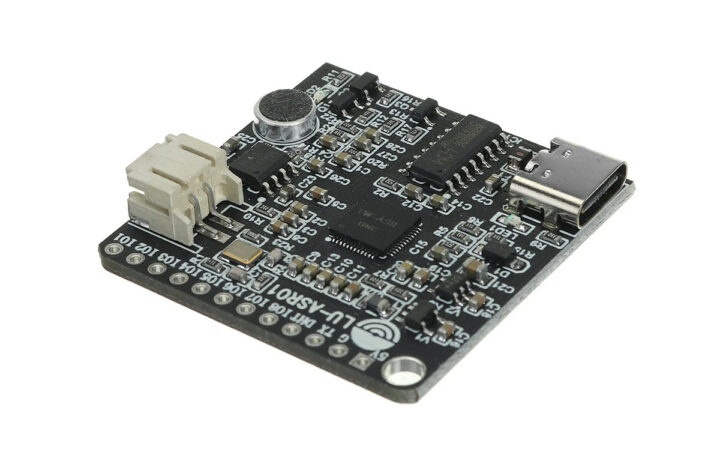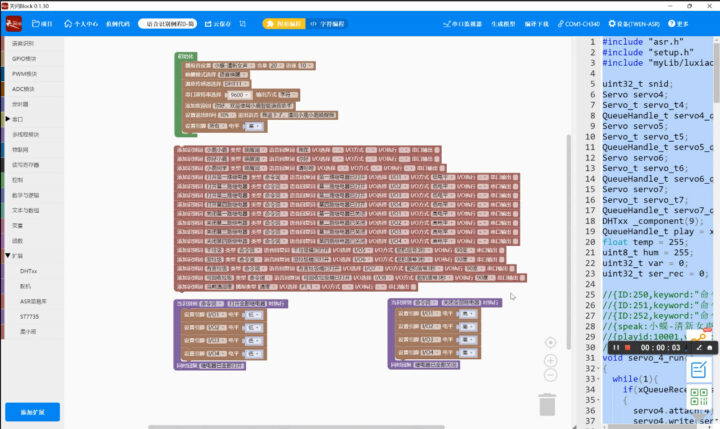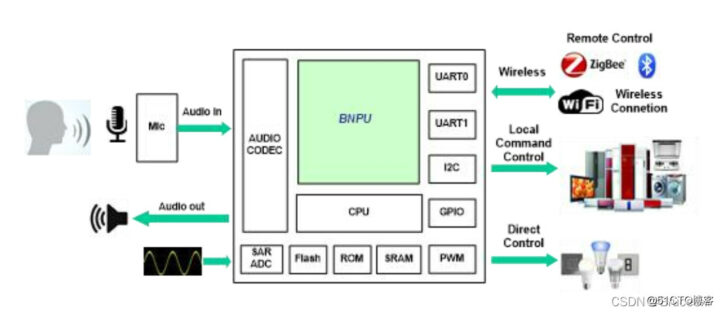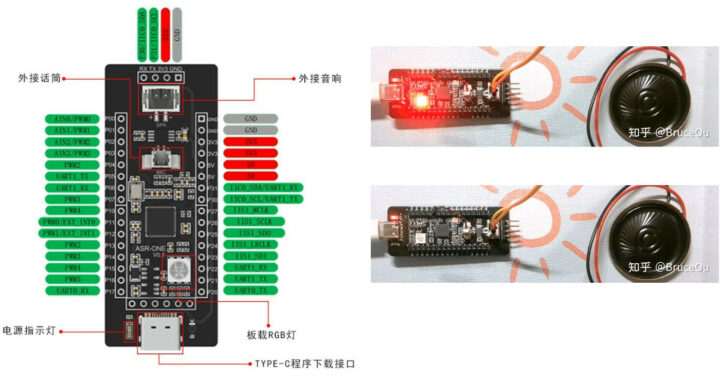LU-ASR01 is a board capable of offline speech recognition with a built-in microphone, a speaker connector, twelve through holes for GPIOs and a temperature sensor interface for DHT11/DS18B20, plus a USB Type-C port for power and programming.
At first, I thought it might be based on the Unisound US516P6 microcontroller which we’ve seen on some inexpensive offline speech recognition modules, but the chip looks completely different, with the marking TW-ASR ONE. So let’s investigate…
 LU-ASR01 board specifications took some effort, but here’s what I’ve managed:
LU-ASR01 board specifications took some effort, but here’s what I’ve managed:
- MCU – TW-ASR ONE (aka TWen ASR ONE) microcontroller with 4MB flash, 512KB RAM, and a BNPU for voice processing; package: QFN48L (6x6x0.85mm)
- Audio I/O
- Built-in microphone
- 2-pin speaker header plus 3W power amplifier for 4Ω/3W speaker
- Voice recognition
- Up to 10 meters wake-up range
- 98% ultra-high recognition rate
- Customizable to 5 wake-up words and 200 recognition words
- USB – 1x USB Type-C port for power and programming via CH340C USB to TTL chip
- Expansion – 12x through holes with 8x GPIOs, of which 6 can be used as PWM, one serial Tx, one DHT11/DS18B20 temperature sensor interface
- Dimensions – About 3.7 x 3.7 cm
- Weight – 35g

Everything is done within this interface including defining wake words and voice commands, monitoring the temperatures, and controlling I/Os, in the sample above some servos. The program is then built and flashed to the board over USB. It’s also possible to directly modify the source code generated from Blockly. At this point, I don’t know if it supports languages other than Mandarin.
If you were to go ahead and give it a try, you may want to check out a 5-part tutorial on Zhihu social network, again in Chinese, that’s more detailed than the information in the RAR file, and in text form, so using machine translation is easier… I could also find a simplified block diagram of the ASR ONE microcontroller as well, and learned that the system runs FreeRTOS.
Note that the review is using another ASR ONE v0.1 board that looks more like a NodeMCU board, but I could not find it for sale.
The LU-ASR01 offline speech recognition board is available now and sold on Banggood for $7.99 including shipping, and you’ll also find it on Aliexpress. Some other shops list it as an upgrade to VRM LD3320 board based on LD3320A and usually selling for over $20.

Jean-Luc started CNX Software in 2010 as a part-time endeavor, before quitting his job as a software engineering manager, and starting to write daily news, and reviews full time later in 2011.
Support CNX Software! Donate via cryptocurrencies, become a Patron on Patreon, or purchase goods on Amazon or Aliexpress







Who do you need to program/configure it? Because it has a limited vocabulary? Just a few words / sentences, like “turn on heating”, “turn off lights”?
It’s not clear. From the presentation, it looks like you can just type any two-word combination for the wake word, and up to 200 voice commands. I’m not sure if the commands are preset, or can be customized and support generated at build time. A few years ago, it took several weeks and thousands of audio samples to have a custom wake word, but now you can just type it and within seconds it’s supported. See Picovoice article for reference.
I’m about to try these, but not sure if it English commands and wake words are supported. Do you think it supports English commands or wake words?
Not sure about that one, but boards based on US516P6 have been shown to work with English wake words and commands.
Sure but creating an account to gain access to their customizing tool is just impossible. I don’t live in China, and they keep asking for a Chinese phone number for verification
it works with English. You can type any English paragraphs into the source code and let the cloud generate the audio library. You then compile the audio lib into the local codes and download the final image to the chip. It gives pretty legit synthesized voice. Yes, u need to be logged in and a Mainland China phone number is needed
where can I get the software to develop ?….thanks in advance
This is also my prob, all the format that i knew in writing a mobile number their system always give a feedback that I sent a wrong format of my mobile number.
Thanks a lot! For my application, I just need the module to output predefined data via UART to a microcontroller, then responses will be handled by a df mini. But just a quick question; do I need a cloud account for customization of command words? My thought is; since it’s AI, it can automatically recognize any spoken words in english and output a predefined data via UART.